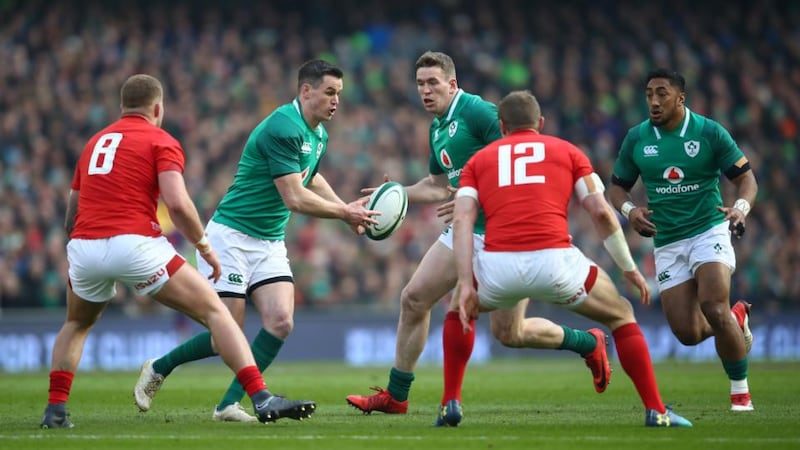Is rugby becoming a younger man's game, as well as a bigger man's game? The question seems particularly apt on the day Jamie Heaslip confirmed his premature retirement from the game due to injury.
Heaslip had always seemed a near certainty to become the next Irish player to reach 100 caps for his country, and while technically he is a Test centurion when one takes into account his Lions tests, ultimately he will now finish with 95 for Ireland.
As Gordon D'Arcy noted in these pages last week, the five Irish players to have played 100 caps or more for their country – all of them of recent vintage – don't look like having any company any time soon. With Heaslip's retirement, the next highest total among active players is Rob Kearney on 81, followed by Cian Healy on 76 and Johnny Sexton on 71.
Certainly, strength in depth is a prerequisite even compared to a decade or so ago. When Ireland won the Grand Slam in 2009, they had virtually no injuries, and Declan Kidney was able to announce an unchanged team and replacements for the first three games in a row, save for one change amongst the replacements when Mick O’Driscoll replaced Malcolm O’Kelly in the third round.
Ultimately the Ireland Grand Slammers of 2009 only used 19 players in their five starting line-ups, and over the course of their campaign, used only 22.
By contrast, Joe Schmidt and his coaching staff have already employed 21 players in their starting line-ups in three matches to date, and 26 players in total.
It’s also remarkable to think that six of Ireland’s starting line-up last Saturday had never played Test rugby at this point a year ago, save for Dan Leavy’s 13 minutes off the bench against Canada the previous November.
That Andrew Porter, James Ryan and Jacob Stockdale were all members of the Irish Under-20 team that reached the final of the World Junior Championships less than two years ago suggests that was a vintage crop or that young players are better prepared, physically, mentally and technically, for international rugby than players before.
The infusion of new blood has given this Irish team some serious physicality and ballast too, particularly when one compares the backlines which faced Wales in the dramatic finale to the 2009 campaign in Cardiff and that which helped to beat Wales last Saturday.
With Rob Kearney the one surviving link, whereas Tommy Bowe was 6ft 3in and weighed 15st 7lbs (or 99kg) and Luke Fitzgerald 6ft 1in and 15st 6lbs (or 98kg), the Irish wings on Saturday were Keith Earls 5ft 10in and 13st 7lbs/86kg and Jacob Stockdale, who is 6ft 3in and 16 stone/102kg.
Acute disappointment
The size difference is most stark in midfield. D'Arcy himself was 5ft 11in and 14st 4lbs, or 91 kg, and Brian O'Driscoll was 5ft 10in and 14st 9lbs/93kg. For their part, Bundee Aki is 6ft 0in tall and weighs 17st 4lbs/101kg, while the 6ft 5in Chris Farrell weighs in at 17st 4lbs/110kg.
Even at half-back, whereas Tomas O'Leary stood 5ft 11in tall and weighted 13st 9lbs, or 87kg, and Ronan O'Gara was 6ft 0in and 13st 4lbs/85kg, Conor Murray is 6ft 2in and 14st 11lbs (94kg), and Johnny Sexton is 6ft 2in and 14st 6lbs, or 92kg.
In other words, in five of those six positions, last Saturday’s backs were both significantly taller and heavier, with the average weight of the 2009 backline at 92.5kg, and that of last Saturday’s pack a bulkier 97.1kg.
Augmented by an array of hard-carrying forwards, compared to the days of Jamie Roberts, George North, Mike Phillips et al, last Saturday was a little like watching the biter being bit at times.
The net effect has to been to leave Ireland strongly placed to reclaim the title from England, and thus win a third Six Nations in five seasons, but in some ways the stakes have now risen for Ireland more than anybody else. They could even win the title before the last week if England fail to match Ireland’s result against Scotland when they subsequently kick off against France in the Stade de France on Saturday week.

Hence, not only would it be an acute disappointment if Ireland didn’t win the title, but likewise it could be an anti-climax if they didn’t win the Slam now as well.
Last week also underlined the huge passion and inspiration which the home team derives from playing in front of their own supporters; cue another three home wins. Akin to last season, when Elliot Daly’s dramatic late try in Cardiff provided the only away win outside of Rome, so this season the only away win outside of Rome so far was courtesy of that 83rd minute drop goal by Johnny Sexton in Paris.
Scotland’s awful away record in the Six Nations has seen them win just six of 48 away games over 18 years, and while one of those was against Ireland in 2010, four of them were in Rome.
Yet recent events, such as Scotland’s win over Ireland last year and England last week, and Ireland’s apparent Achilles heel of conceding tries out wide, especially in the final quarter, should keep a lid on any hint of complacency amongst home team or crowd alike on Saturday week.
Put another way, even were Ireland to build up a lead going into the final quarter, nobody will take anything for granted prematurely.
This Irish team has already scored more tries than the heroes of 2009, though the Grand Slam winners conceded only three tries in five games. But as the then defensive coach, Les Kiss, said of them they were a cardiac team, and the same seemingly applies to this 2018 vintage too.
gthornley@gmail.com











